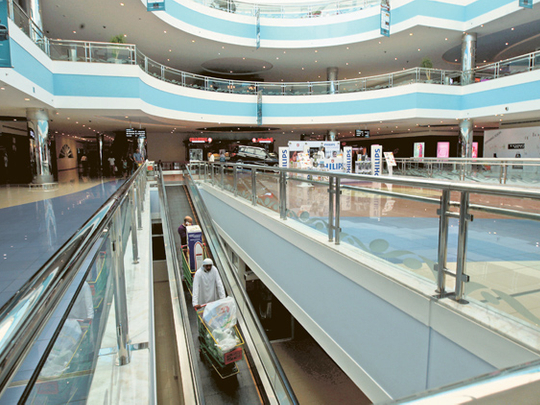
Dubai It's a tale of multiple retail trends as opposed to a single dominant theme in the city of Abu Dhabi. With the opening of the Yas Mall, a mega development in all respects, drawing closer, each of these trends is now being brought into sharper focus.
Not just that, Abu Dhabi city and its immediate environs will have other malls competing for retailer and shopper attention.
There will be the Galleria at Sowwah Square on Al Maryah Island with its 120 top-notch luxury brands and food and beverage offerings, while the Emporium (Central Market) will host the House of Fraser, which will be Abu Dhabi's first full-fledged department store when it opens early next year.
Meanwhile, Al Wahda Mall, which has already cut a fine profile for itself, is expected to add another 40 brands as part of an expansion due to be completed after summer.
Over-supply concerns
All of these projects have inevitably led to concerns of a massive over-supply of retail stock in the emirate. Andrew Goodwin, director at property consultancy DTZ, believes the concerns are over-exaggerated. (DTZ estimates retail spending in Abu Dhabi at a staggering Dh17 billion.)
"Critically, if these malls target new markets that are not properly represented in Abu Dhabi at present, then the capital will capture increased spending to support the new retail," Goodwin said.
"Over-supply is most at risk in the off-island locations where, in the future, the comparison and fashion shopping is likely to be dominated by Dalma Mall.
"New malls will have to find a community niche to make them relevant to the immediate catchment. Where housing is yet to be developed, these are likely to become dominated by foodstore and convenience offers rather than fashion."
By DTZ's reckoning, Abu Dhabi's overall retail area would swell to 1.81 million square metres by 2015, which is inclusive of street-side shops and other smaller schemes as well as those at the malls. Malls on their own would make up a substantial 1.41 million square metres by then compared to the 709,329 square metres now.
This leaves homegrown retailers and global brand owners with plenty to choose from. Some would say this makes it even more difficult for them to make up their minds about where to be.
Steady pipeline
Manu Jeswani, director at the Landmark Group, begs to differ. "Abu Dhabi does have a strong pipeline for a large amount of retail space, but with the anticipated growth, it is expected this will be absorbed. The surge in malls is a natural progression related to the demand within the market."
The consumer base already exists and continues to grow. By DTZ's projections, the emirate's population could touch 1.2 million by 2014 from the estimated 1.05 million.
While that's quite a substantial number for the new capacities being created, mall owners and retailers will still need to plug a few gaps. The biggest gap that exists right now is the way a significant portion of Abu Dhabi's resident base continues to head for Dubai to do their shopping.
"Through an independent survey, DTZ found that 20 per cent of Abu Dhabi's population travel to Dubai regularly for shopping trips", said a report on Abu Dhabi's retail sector issued by the firm. "Of this 20 per cent, 80 per cent are in the high-income bracket. DTZ estimates that Abu Dhabi's retail spending is at Dh17 billion and to capture this important channel, it must look to improve the overall standard of retail offer in both its destination mall and luxury goods offer."
This, in a nutshell, needs to be rectified because Abu Dhabi's malls cannot as yet expect tourism-driven shoppers to contribute in the way they do in Dubai.
DTZ estimates that 41 per cent of the current retail stock is represented by poorly maintained street-side outlets. "Measures are already under way for the improvement of this through the limiting of business licences for trade uses," the report added.
While that would take care of the inferior stock, other government-led policies at a much broader level would play well to the needs of the new age malls coming through the pipeline, industry sources affirm.
"The demographic movement in Abu Dhabi is much more planned and structured, driven by government policies towards sustainable population placement," said Raja Abdul Khader, director at Line Investments and Property, which manages seven major malls in the city, including Al Wahda.
Future strategy
"The Abu Dhabi 2030 strategy is to diversify secondary suburban areas which would create additional audience for retail developments. Secondary catchments like Mohammad Bin Zayed City and Khalifa City would have self-contained community retail developments catering to the immediate population.
"There are no new retail developments assigned within mainland Abu Dhabi, which steers away concerns that there would be an over-supply."
That is also why retail industry sources are quite confident that the marketplace can easily absorb the 235,000 square metres of Yas Mall, which is located outside of the city and is scheduled for a partial opening in the latter half of next year. More than 50 per cent of the space is already leased, according to the developer, Aldar Properties.
The Yas Mall will also provide Abu Dhabi with the ‘regional mall' — similar to The Dubai Mall or the Mall of the Emirates — that it lacks in. This will, according to DTZ, stem the ‘leakage of trade to Dubai'.
"The critical mass of this coupled with adjoining leisure activities will create a major destination for shopping in a new location and help to distribute the trade throughout the metropolitan area."











